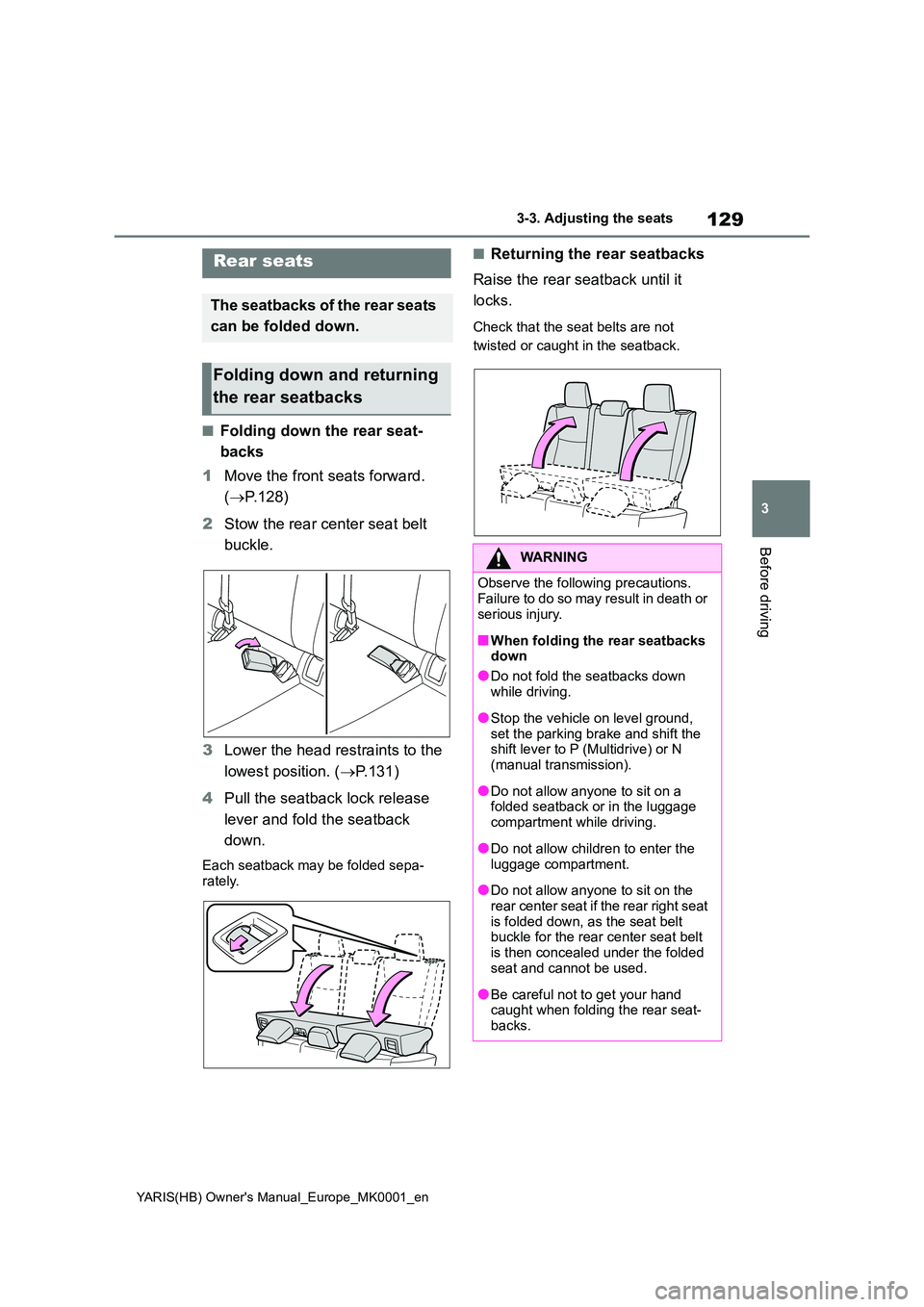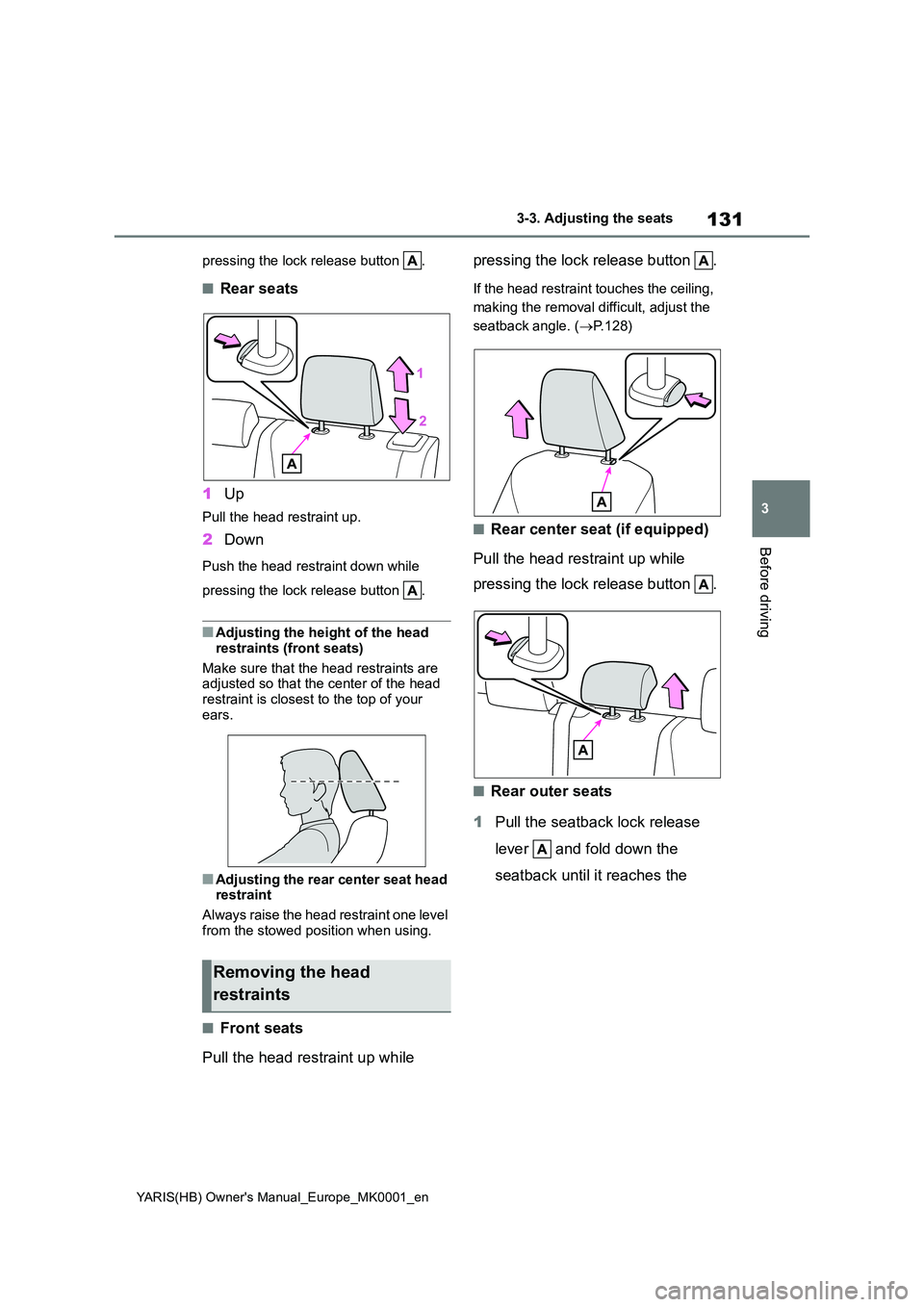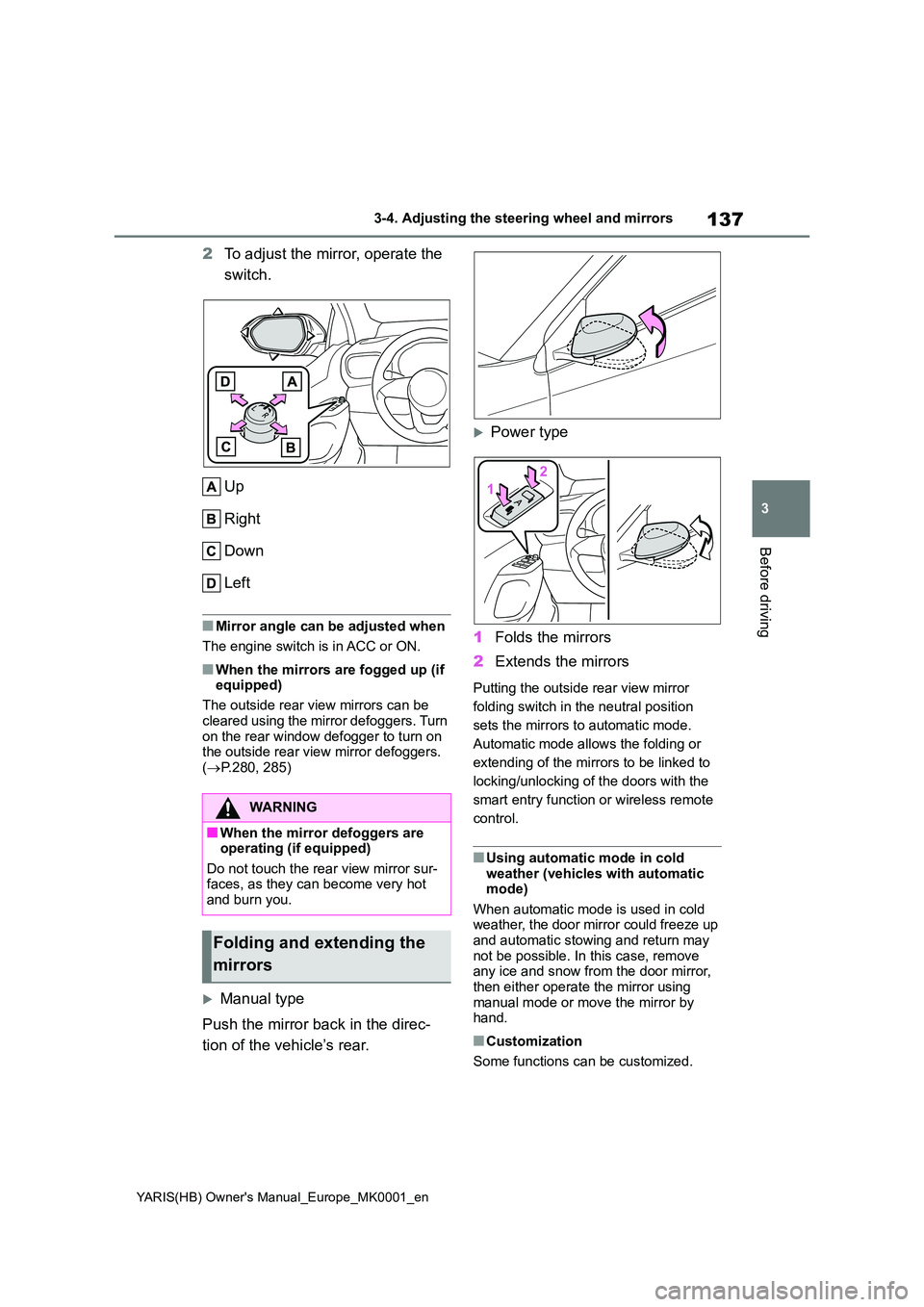2021 TOYOTA YARIS HATCHBACK tow
[x] Cancel search: towPage 114 of 568

114
YARIS(HB) Owner's Manual_Europe_MK0001_en
3-1. Key information
The keys are equipped with the fol-
lowing wireless remote control:
Vehicles without a smart entry &
start system
Locks the doors ( →P. 1 1 6 )
Closes the windows* ( →P. 1 1 6 )
Unlocks the doors ( →P. 1 1 6 )
Opens the windows* ( →P. 1 1 6 )
Vehicles with a smart entry &
start system
Locks the doors ( →P. 1 1 6 )
Closes the windows* ( →P. 1 1 6 )
Unlocks the doors ( →P. 1 1 6 )
Opens the windows* ( →P. 1 1 6 )
*: This setting must be customized at
any authorized Toyota retailer or
Toyota authorized repairer, or any
reliable repairer.
■Conditions affecting the operation
of the wireless remote control (vehicles without a smart entry & start system)
The wireless remote control function may not operate normally in the follow-ing situations:
●When the wireless key battery is depleted
●Near a TV tower, electric power plant, gas station, radio station, large dis-
play, airport or other facility that gen- erates strong radio waves or electrical noise
●When carrying a portable radio, cellu-lar phone or other wireless communi-
cation devices
●When the wireless key is in contact
with, or is covered by a metallic object
●When another wireless key (that emits
radio waves) is being used nearby
●If window tint with a metallic content or
metallic objects are attached to the rear window
■Conditions affecting the operation of the smart entry & start system or
wireless remote control (vehicles with a smart entry & start system)
→ P. 1 2 4
NOTICE
■When an electronic key is lost (vehicles with a smart entry &
start system)
→ P. 3 9 9
Wireless remote control
Page 115 of 568

115
3
YARIS(HB) Owner's Manual_Europe_MK0001_en
3-1. Key information
Before driving
1Releasing
To release the key, press the button
2Folding
To stow the key, press the button then
fold the key.
To take out the mechanical key,
slide the release lever and take
the key out.
The mechanical key can only be
inserted in one direction, as the key
only has grooves on one side. If the
key cannot be inserted in a lock cyl-
inder, turn it over and re-attempt to
insert it.
After using the mechanical key,
store it in the electronic key. Carry
the mechanical key together with
the electronic key. If the electronic
key battery is depleted or the entry
function does not operate properly,
you will need the mechanical key.
( →P.399)
■If you lose your mechanical keys
→ P. 3 9 9
■Certification for the wireless remote control
→ P. 4 4 4
Using the key (vehicles with-
out a smart entry & start
system)
Using the mechanical key
(vehicles with a smart entry
& start system)
Page 124 of 568

124
YARIS(HB) Owner's Manual_Europe_MK0001_en
3-2. Opening, closing and locking the doors
●Interior buzzer sounds continuously
■Battery-saving function
The battery-saving function will be acti-
vated in order to prevent the electronic
key battery and the vehicle battery from
being discharged while the vehicle is not
operated for a long time.
●In the following situations, the smart
entry & start system may take some
time to unlock the doors.
• The electronic key has been left within
approximately 3.5 m (11 ft.) of the out-
side of the vehicle for 2 minutes or
longer.
• The smart entry & start system has
not been used for 5 days or longer.
●If the smart entry & start system has
not been used for 14 days or longer,
the doors cannot be unlocked from
any door except the driver’s door. In
this case, hold the driver’s door han-
dle, or use the wireless remote control
or mechanical key to unlock the
doors.
■Electronic key battery-saving func-
tion
●When battery-saving mode is set, bat-
tery depletion is minimized by stop-
ping the electronic key from receiving
radio waves.
Press twice while pressing and holding . Confirm that the electronic
key indicator flashes 4 times.
While the battery-saving mode is set,
the smart entry & start system cannot be
used. To cancel the function, press any
of the electronic key buttons.
●Electronic keys that will not be used
for long periods of time can be set to
the battery-saving mode in advance.
■Conditions affecting operation
The smart entry & start system uses
weak radio waves. In the following situa-
tions, the communication between the
electronic key and the vehicle may be
affected, preventing the smart entry &
start system, wireless remote control
and engine immobilizer system from
operating properly. (Ways of coping:
→P.399)
●When the electronic key battery is
depleted
●Near a TV tower, electric power plant,
gas station, radio station, large dis-
play, airport or other facility that gen-
erates strong radio waves or electrical
noise
●When carrying a portable radio, cellu-
lar phone, cordless phone or other
wireless communication device
●When the electronic key is in contact
with, or is covered by the following
metallic objects
• Cards to which aluminum foil is
attached
• Cigarette boxes that have aluminum
foil inside
• Metallic wallets or bags
•Coins
SituationCorrection
procedure
The engine switch was
turned to ACC while the
driver’s door was open
(or the driver’s door
was opened while the
engine switch was in
ACC).
Turn the
engine switch
off and close
the driver’s
door.
The engine switch was
turned to off while the
driver’s door was open.Close the
driver ’s door.
Page 129 of 568

129
3
YARIS(HB) Owner's Manual_Europe_MK0001_en
3-3. Adjusting the seats
Before driving
■Folding down the rear seat-
backs
1 Move the front seats forward.
( →P.128)
2 Stow the rear center seat belt
buckle.
3 Lower the head restraints to the
lowest position. ( →P.131)
4 Pull the seatback lock release
lever and fold the seatback
down.
Each seatback may be folded sepa-
rately.
■Returning the rear seatbacks
Raise the rear seatback until it
locks.
Check that the seat belts are not
twisted or caught in the seatback.
Rear seats
The seatbacks of the rear seats
can be folded down.
Folding down and returning
the rear seatbacks
WARNING
Observe the following precautions.
Failure to do so may result in death or serious injury.
■When folding the rear seatbacks down
●Do not fold the seatbacks down
while driving.
●Stop the vehicle on level ground,
set the parking brake and shift the shift lever to P (Multidrive) or N (manual transmission).
●Do not allow anyone to sit on a folded seatback or in the luggage
compartment while driving.
●Do not allow children to enter the
luggage compartment.
●Do not allow anyone to sit on the
rear center seat if the rear right seat is folded down, as the seat belt buckle for the rear center seat belt
is then concealed under the folded seat and cannot be used.
●Be careful not to get your hand caught when folding the rear seat-backs.
Page 131 of 568

131
3
YARIS(HB) Owner's Manual_Europe_MK0001_en
3-3. Adjusting the seats
Before driving
pressing the lock release button .
■Rear seats
1 Up
Pull the head restraint up.
2Down
Push the head restraint down while
pressing the lock release button .
■Adjusting the height of the head
restraints (front seats)
Make sure that the head restraints are adjusted so that the center of the head
restraint is closest to the top of your ears.
■Adjusting the rear center seat head restraint
Always raise the head restraint one level
from the stowed position when using.
■Front seats
Pull the head restraint up while
pressing the lock release button .
If the head restraint touches the ceiling,
making the removal difficult, adjust the
seatback angle. ( →P.128)
■Rear center seat (if equipped)
Pull the head restraint up while
pressing the lock release button .
■Rear outer seats
1 Pull the seatback lock release
lever and fold down the
seatback until it reaches the
Removing the head
restraints
Page 137 of 568

137
3
YARIS(HB) Owner's Manual_Europe_MK0001_en
3-4. Adjusting the steering wheel and mirrors
Before driving
2To adjust the mirror, operate the
switch.
Up
Right
Down
Left
■Mirror angle can be adjusted when
The engine switch is in ACC or ON.
■When the mirrors are fogged up (if equipped)
The outside rear view mirrors can be
cleared using the mirror defoggers. Turn on the rear window defogger to turn on the outside rear view mirror defoggers.
( →P.280, 285)
Manual type
Push the mirror back in the direc-
tion of the vehicle’s rear.
Power type
1 Folds the mirrors
2 Extends the mirrors
Putting the outside rear view mirror
folding switch in the neutral position
sets the mirrors to automatic mode.
Automatic mode allows the folding or
extending of the mirrors to be linked to
locking/unlocking of the doors with the
smart entry function or wireless remote
control.
■Using automatic mode in cold weather (vehicles with automatic mode)
When automatic mode is used in cold weather, the door mirror could freeze up and automatic stowing and return may
not be possible. In this case, remove any ice and snow from the door mirror, then either operate the mirror using
manual mode or move the mirror by hand.
■Customization
Some functions can be customized.
WARNING
■When the mirror defoggers are operating (if equipped)
Do not touch the rear view mirror sur- faces, as they can become very hot and burn you.
Folding and extending the
mirrors
Page 143 of 568

4
143
YARIS(HB) Owner's Manual_Europe_MK0001_en
4
Driving
Driving
4-1. Before driving
Driving the vehicle ............ 144
Cargo and luggage ........... 151
Trailer towing (vehicles without
towing packages - including
Reunion) ......................... 152
Trailer towing (vehicles with
towing packages - except for
Reunion) ......................... 152
4-2. Driving procedures
Engine (ignition) switch (vehi-
cles without a smart entry &
start system) ................... 158
Engine (ignition) switch (vehi-
cles with a smart entry & start
system) ........................... 159
Multidrive .......................... 164
Manual transmission......... 168
Turn signal lever ............... 171
Parking brake ................... 171
4-3. Operating the lights and wip-
ers
Headlight switch ............... 173
Automatic High Beam ....... 177
Fog light switch ................. 180
Windshield wipers and washer
....................................... 181
Rear window wiper and washer
....................................... 184
4-4. Refueling
Opening the fuel tank cap. 186
4-5. Using the driving support
systems
Toyota Safety Sense ......... 188
PCS (Pre-Collision System)
........................................ 193
LTA (Lane Tracing Assist) . 203
Dynamic radar cruise control
........................................ 213
Speed limiter ..................... 224
RSA (Road Sign Assist) .... 226
Stop & Start system .......... 230
BSM (Blind Spot Monitor) . 237
Toyota parking assist-sensor
........................................ 242
RCTA (Rear Crossing Traffic
Alert) ............................... 247
PKSB (Parking Support Brake)
........................................ 251
Parking Support Brake function
(static objects) ................ 256
Parking Support Brake function
(rear-crossing vehicles) .. 262
Driving mode select switch 266
GPF (Gasoline Particulate Fil-
ter) system ...................... 267
Driving assist systems ...... 268
4-6. Driving tips
Winter driving tips ............. 274
Page 146 of 568

146
YARIS(HB) Owner's Manual_Europe_MK0001_en
4-1. Before driving
• When the accelerator pedal is
depressed too much while the vehicle is in reverse.
●While Drive-Start Control is being acti-vated, your vehicle may have trouble escaping from the mud or fresh snow.
In such case, deactivate TRC ( →P.269) to cancel Drive-Start Control so that the vehicle may become able
to escape from the mud or fresh snow.
■Breaking in your new Toyota
To extend the life of the vehicle, observ- ing the following precautions is recom-
mended:
●For the first 300 km (186 miles):
Avoid sudden stops.
●For the first 800 km (500 miles):
Do not tow a trailer. (vehicles with tow-
ing packages only)
●For the first 1000 km (621 miles): • Do not drive at extremely high speeds.
• Avoid sudden acceleration. • Do not drive continuously in low gears.
• Do not drive at a constant speed for extended periods.
■Operating your vehicle in a foreign country
Comply with the relevant vehicle regis- tration laws and confirm the availability of the correct fuel. ( →P.413)
WARNING
Observe the following precautions. Failure to do so may result in death or serious injury.
■When starting the vehicle (vehi-cles with a Multidrive)
Always keep your foot on the brake pedal while stopped with the engine running. This prevents the vehicle
from creeping.
■When driving the vehicle
●Do not drive if you are unfamiliar with the location of the brake and
accelerator pedals to avoid depressing the wrong pedal.
• Accidentally depressing the accel- erator pedal instead of the brake pedal will result in sudden accelera-
tion that may lead to an accident.
• When backing up, you may twist
your body around, leading to a diffi- culty in operating the pedals. Make sure to operate the pedals properly.
• Make sure to keep a correct driving posture even when moving the
vehicle only slightly. This allows you to depress the brake and accelera-tor pedals properly.
• Depress the brake pedal using your right foot. Depressing the brake
pedal using your left foot may delay response in an emergency, result-ing in an accident.
●Do not drive the vehicle over or stop the vehicle near flammable
materials. The exhaust system and exhaust gases can be extremely hot. These
hot parts may cause a fire if there is any flammable material nearby.
●During normal driving, do not turn off the engine. Turning the engine off while driving will not cause loss
of steering or braking control, but the power assist to these systems will be lost. This will make it more
difficult to steer and brake, so you should pull over and stop the vehi-cle as soon as it is safe to do so.
However, in the event of an emer- gency, such as if it becomes impos-sible to stop the vehicle in the
normal way: →P. 3 6 0